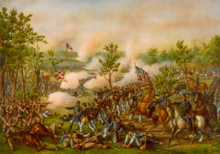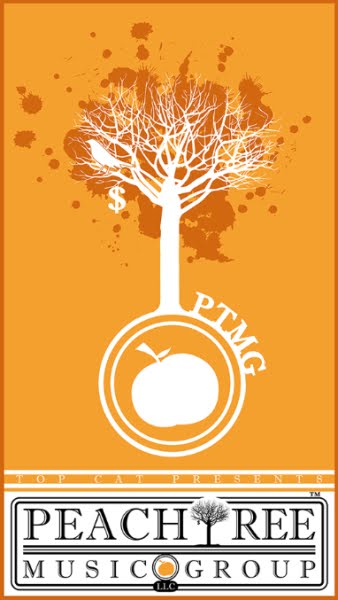History of Atlanta
Prior to the arrival of European settlers in north Georgia, Creek and Cherokee Indians inhabited the area. Standing Peachtree, a Creek village located where Peachtree Creek flows into the Chattahoochee River, was the closest Indian settlement to what is now Atlanta. As part of the systematic removal of Native Americans from northern Georgia from 1802 to 1825, the Creek ceded the area in 1821, and white settlers arrived the following year.
Marietta Street, 1864
In 1836, the Georgia General Assembly voted to build the Western and Atlantic Railroad in order to provide a link between the port of Savannah and the Midwest. The initial route was to run southward from Chattanooga to a terminus east of the Chattahoochee River, which would then be linked Savannah. After engineers surveyed various possible locations for the terminus, the "zero milepost" was driven into the ground in what is now Five Points. A year later, the area around the milepost had developed into a settlement, first known as “Terminus,” and later as “Thrasherville” after a local merchant who built homes and a general store in the area. By 1842, the town had six buildings and 30 residents, and was renamed "Marthasville" to honor the Governor’s daughter. J. Edgar Thomson, Chief Engineer of the Georgia Railroad, suggested the town be renamed "Atlantica-Pacifica,” which was shortened to "Atlanta." The residents approved, and the town was incorporated as Atlanta on December 29, 1847.
By 1860, Atlanta’s population had grown to 9,554. During the Civil War, the nexus of multiple railroads in Atlanta made the city a hub for the distribution of military supplies. In 1864, following the capture of Chattanooga, the Union Army moved southward and began its invasion of north Georgia. The region surrounding Atlanta was the location of several major army battles, culminating with the Battle of Atlanta and a four-month-long siege of the city by the Union Army under the command of General William Tecumseh Sherman. On September 1, 1864, Confederate General John Bell Hood made the decision to retreat from Atlanta, ordering all public buildings and possible assets to the Union Army destroyed. On the next day, Mayor James Calhoun surrendered Atlanta to the Union Army, and on September 7, General Sherman ordered the city’s civilian population to evacuate. On November 11, 1864, in preparation of the Union Army’s march to Savannah, Sherman ordered Atlanta to burned to the ground, sparing only the city’s churches and hospitals.

Battle of Atlanta during US Civil War, 1864
After the Civil War ended in 1865, Atlanta was gradually rebuilt. Due to the city’s superior rail transportation network, the state capital was moved to Atlanta from Milledgeville in 1868. In the 1880 Census, Atlanta surpassed Savannah as Georgia’s largest city. Beginning in the 1880s, Henry W. Grady, the editor of the ‘‘Atlanta Constitution’’ newspaper, promoted Atlanta to potential investors as a city of the "New South" that would be based upon a modern economy and less reliant on agriculture. By 1885, the founding of the Georgia School of Technology (now Georgia Tech) and the city’s black colleges had established the city as a center for higher education. In 1895, Atlanta hosted the Cotton States and International Exposition, which attracted nearly 800,000 attendees and successfully promoted the New South’s development to the world.
During the first decades of the twentieth century, Atlanta experienced a period of unprecedented growth. In three decades’ time, Atlanta’s population tripled as the city limits expanded to include nearby streetcar suburbs; the city’s skyline emerged with the construction of the Equitable, Flatiron, Empire, and Candler buildings; and Sweet Auburn emerged as a center of black commerce. However, the period was also marked by strife and tragedy. Increased racial tensions led to the Atlanta Race Riot of 1906, which left at least 27 people dead and over 70 injured. In 1915, Leo Frank, a Jewish-American factory superintendent, was hanged by a lynch mob, drawing attention to antisemitism in the United States. On May 21, 1917, the Great Atlanta Fire destroyed 1,938 buildings in what is now the Old Fourth Ward, resulting in one fatality and the displacement of 10,000 people.
In 1907, Peachtree Street, the main street of Atlanta, was busy with streetcars and automobiles.
On December 15, 1939, Atlanta hosted the film premiere of Gone with the Wind, the epic film based on the best-selling novel by Atlanta’s Margaret Mitchell. The film's legendary producer, David O. Selznick, as well as the film's stars Clark Gable, Vivien Leigh, and Olivia de Havilland attended the gala event at Loew's Grand Theatre, but Oscar winner Hattie McDaniel, an African American, was barred from the event due to the color of her skin.
Atlanta played a vital role in the Allied effort during World War II due the city’s war-related manufacturing companies, railroad network, and military bases, leading to rapid growth in the city's population and economy. In the 1950s, the city’s newly constructed freeway system allowed middle class Atlantans the ability to relocate to the suburbs. As a result, the city began to make up an ever smaller proportion of the metropolitan area’s population, eventually decreasing from 31% in 1960 to 9% in 2000.
During the 1960s, Atlanta was a major organizing center of the Civil Rights Movement, with Dr. Martin Luther King, Jr., Ralph David Abernathy, and students from Atlanta’s historically black colleges and universities playing major roles in the movement’s leadership. While minimal compared to other cities, Atlanta was not completely free of racial strife. In 1961, the city attempted to thwart blockbusting by erecting road barriers in Cascade Heights, countering the efforts of civic and business leaders to foster Atlanta as the "city too busy to hate." Desegregation of the public sphere came in stages, with public transportation desegregated by 1959, the restaurant at Rich's department store by 1961, movie theaters by 1963, and public schools by 1973.
The diving event at the 1996 Summer Games, with Atlanta’s Olympic logo in the background
By 1970, African Americans were a majority of the city’s population and exercised new-found political influence by electing Atlanta’s first black mayor, Maynard Jackson, in 1973. Under Mayor Jackson’s tenure, Atlanta’s airport was modernized, solidifying the city’s role as a transportation center. The opening of the Georgia World Congress Center in 1976 heralded Atlanta’s rise as a convention city. Construction of the city’s subway system began in 1975, with rail service commencing in 1979. However, despite these improvements, Atlanta succumbed to the same decay afflicting major American cities during the era, and the city lost over 100,000 residents between 1970 and 1990, over 20% of its population.
In 1990, Atlanta was selected as the site for the 1996 Summer Olympic Games. Following the announcement, the city government undertook several major construction projects to improve Atlanta’s parks, sporting venues, and transportation infrastructure. While the games themselves were marred by numerous organizational inefficiencies, as well as the Centennial Olympic Park bombing, they were a watershed event in Atlanta’s history, initiating a fundamental transformation of the city in the decade that followed.
During the 2000s, Atlanta underwent a profound transformation demographically, physically, and culturally. Suburbanization, rising prices, a booming economy, and new migrants decreased the city’s black percentage from a high of 67% in 1990 to 54% in 2010. From 2000 to 2010, Atlanta gained 22,763 white residents, 5,142 Asian residents, and 3,095 Hispanic residents, while the city’s black population decreased by 31,678. Much of the city’s demographic change during the decade was driven by young, college-educated professionals: from 2000 to 2009, the three-mile radius surrounding Downtown Atlanta gained 9,722 residents aged 25 to 34 holding at least a four-year degree, an increase of 61%. Between the mid-1990s and 2010, stimulated by funding from the HOPE VI program, Atlanta demolished nearly all of its public housing, a total of 17,000 units and about 10% of all housing units in the city. In 2005, the $2.8 billion BeltLine project was adopted, with the stated goals of converting a disused 22-mile freight railroad loop that surrounds the central city into an art-filled multi-use trail and increasing the city’s park space by 40%. Lastly, Atlanta’s cultural offerings expanded during the 2000s: the High Museum of Art doubled in size; the Alliance Theatre won a Tony Award; and numerous art galleries were established on the once-industrial Westside.

















































































